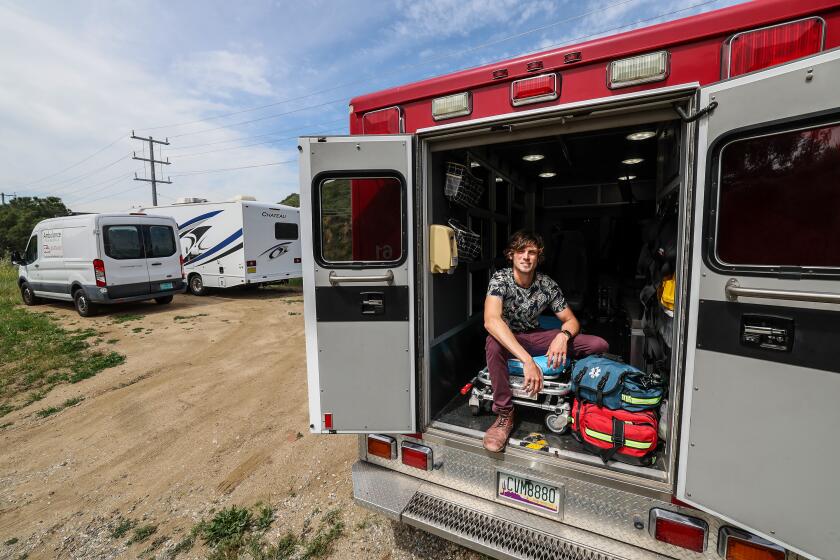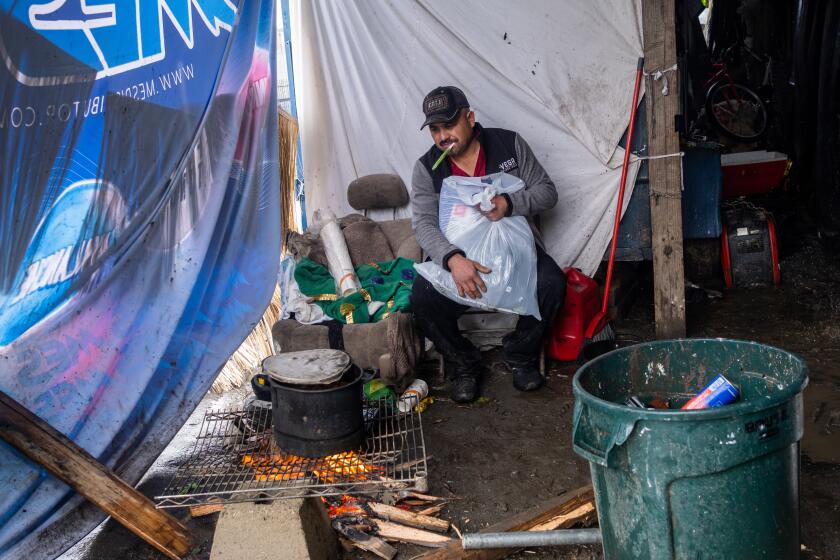Helping homeless addicts can take a whole team
I started seeing Daniel in June 2005 at a small urgent-care clinic I run for mostly injection-drug users on skid row. An addict, he was a tall, thin man with long, stringy gray hair and an unkempt beard. My notes from our initial conversation described him as “disheveled, dirty and lethargic.” On subsequent visits, he often had food or vomit in his beard and would come to the clinic smelling of urine. He seldom had much to say.
Then, in May 2006, I saw a different side of Daniel, whom I will refer to only by his first name to protect his privacy, although he has agreed to let me tell his story. During one of his visits to the clinic, he kept his head down and tears welled up in his powder-blue eyes, but he talked as he never had before. Things weren’t good. He’d been jumped the previous week, he told me in his Kentucky drawl. He hated who he’d become, he said — a loner, someone who didn’t care about others. “I used to play the guitar professionally,” he said regretfully. “I was in a band. I had a life.”
Listening to him, I had a realization: He was severely depressed. Until then, I’d assumed that he, like so many others on skid row, was schizophrenic. Schizophrenia is frustratingly difficult to treat, but depression has many effective treatments. My realization about his depression also put his addiction in a different light. He might well be using heroin in an attempt to treat his depression.
Most of the drug addicts I see are self-treating, whether for mental illness, chronic pain or both. Perhaps if we could treat the underlying depression, Daniel might be able to stop self-medicating with heroin. Homeless people die young: Their average lifespan, according to studies, is 47. So getting Daniel off drugs and off the streets was a high priority.
That did not prove easy. I tried, after realizing he was depressed, to refer him to a mental health clinic. But he never went. Finally, I gave him some samples of Seroquel, which treats depression and psychosis. After that, I didn’t see him for two months. When he finally came again, he had a short explanation: “Got picked up.” Jail. “I was thinking about ending it all, Doc…. on my birthday.” Again I prodded him to try the Seroquel.
Instead, he again quit coming to the clinic regularly.
Through much of 2007 and 2008, I saw Daniel only sporadically. He came in when he had a medical issue that needed attention — at one point he had a painful groin hernia — then we didn’t see him for a while. But there was one big change in 2008. A new county program was connecting mentally ill homeless patients with case managers who could help them obtain psychiatric and medical care, drug treatment and housing.
Daniel qualified for the program and was assigned to a caseworker, Pearlina. But I soon heard that he wasn’t keeping his appointments with her. Meanwhile, he had increased his heroin use to deal with the pain from his hernia. Because of his addiction, finding a hospital that would perform surgery was complicated.
I called his caseworker. “Pearlina,” I told her, “you’re going to have to come to the needle exchange in order to see him.” She agreed, and the director of the needle exchange agreed to call the next time Daniel showed up.
Finally, Daniel met with Pearlina at the needle exchange. But he continued to frustrate us. He never kept the psychiatry appointments I made for him. And he also missed a preoperative appointment to get his hernia taken care of. Pearlina found a sober-living home for Daniel, but he left after a day.
Over the next couple of months, there were a few signs of progress, but they were usually followed by disappointment. James took Daniel to the Department of Motor Vehicles to get an ID card. He also hooked him up with a methadone clinic. But then Daniel missed his appointment with the methadone clinic because he got arrested.
In December 2008, looking at Daniel’s now mango-sized hernia, I realized we needed to intervene more dramatically. He couldn’t stop heroin because of the pain from his hernia. He couldn’t get clean without being housed. Finally, the Harbor- UCLA family medicine team agreed to hospitalize Daniel for his pre-op evaluation, and a surgeon colleague agreed to operate on him. Pearlina found Daniel housing at the Weingart Center in the skid row area, so he would have a place to go after discharge. I requested that Daniel be provided with methadone while he was hospitalized. And James got a methadone clinic to hold a spot for Daniel for when he was discharged. Most important, Daniel agreed to it all.
On Feb. 9, 2009, Daniel had surgery. The next month, at his request, he entered a detox program, followed by a 90-day residential drug treatment program. He also started taking psychiatric medication.
When I next saw him, a couple of months later, his hair was shiny and his beard was nicely trimmed. He had gained about 40 pounds. He had life in his powder-blue eyes.
Studies have shown that housing the homeless cuts death rates by up to 500%, and that assertive community treatment for people with mental illness, which includes housing, results in people being 62% less symptomatic. These things often take, as was the case with Daniel, a team of professionals all pulling in the same direction. That kind of intervention and care are expensive. But in many cases, they are far less expensive than the alternative: a cycle of arrests, hospitalizations and emergency medical treatments.
Despite their effectiveness, county programs like the one that helped Daniel are always threatened by budget constraints. But we need to keep fighting for them, so that men and women like Daniel have a shot at fulfilling lives.
After Daniel’s drug treatment, Pearlina and others helped him find a sober-living house in San Pedro. He’s still there today, where he remains clean and sober. He’s saving up to buy a guitar.
Susan Partovi is an attending physician at Harbor-UCLA and the medical director for Homeless Health Care Los Angeles.



